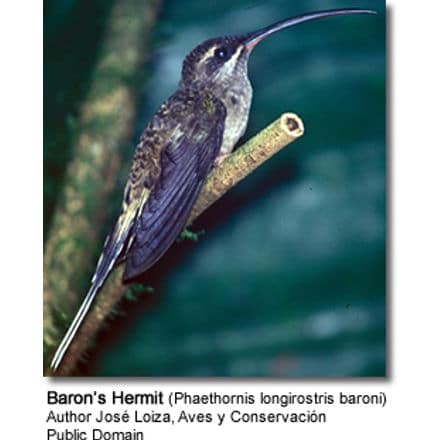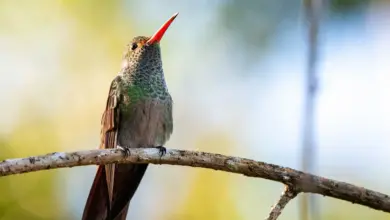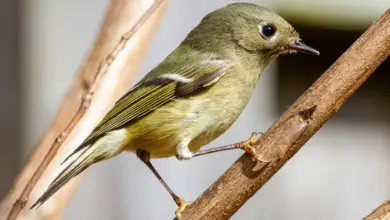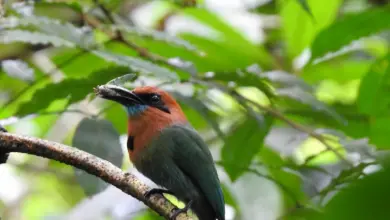Long-billed Hermits
The Long-billed Hermits (Phaethornis longirostris) – also known as Western Long-tailed Hermit – is a large hummingbird that occurs naturally in central Mexico south to northwestern Colombia, extreme western Venezuela and western Ecuador.
They live in forest undergrowth, typically near water and its preferred breeding and feeding habitat.
Subspecies and Distribution:
- Long-tailed Hermit(Phaethornis longirostris longirostris – DeLattre, 1843) – Nominate Race
- Found in southern Mexico (northern Oaxaca) to northern Honduras
- Jalisco Hermit (Phaethornis longirostris griseoventer – Phillips, 1962)
- Found in western Mexico (Nayarit to Colima)
- Mexican or Hartert’s Hermit(Phaethornis longirostris mexicanus – Hartert, 1897)
- Found in southwestern Mexico (western Guerrero to southeastern Oaxaca)
- Phaethornis longirostris cephalus (Bourcier and Mulsant, 1848)
- Found in eastern Honduras to northwestern Colombia
- Phaethornis longirostris sussurus (Bangs, 1901)
- Found in northern Colombia (Santa Marta Mountains)
- Phaethornis longirostris baroni (Hartert, 1897)
- Found in western Ecuador and northwestern Peru

Alternate (Global) Names
Spanish: Ermitaño Colilargo, Ermitaño Colilargo Norteño … French: Ermite à longue queue
German: Westlicher Langschwanz-Schattenkolibri … Czech: kolib?ík západní … Danish: Langhalet Eremit … Finnish: pohjanerakkokolibri … Norwegian: Veststjerteremitt … Polish: pustelnik dlugodzioby, pustelnik d?ugodzioby … Russian: ???????????? ????????? ??????? … Slovak: slnecnícek dlhozobý … Swedish: Långstjärtad eremit
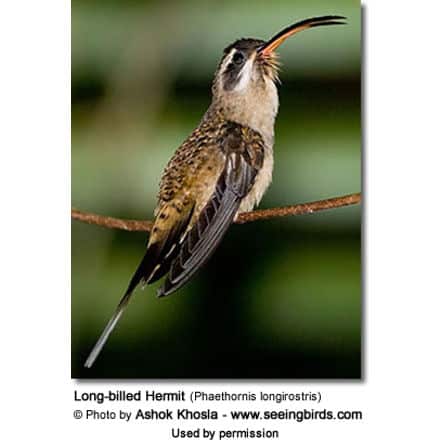
Description
The Long-billed Hermit averages 6 inches (15 cm) in length (including its bill and tail) and weighs around 0.2 oz (6 g). It has a very long and down-curved bill that is about 1.3 – 1.5 inches (3.4 – 3.7 cm). The central feathers of the tapered tail are about 2.5 – 2.7 inches (6.3- 6.8 cm) long and white-tipped.
The upper plumage of the adult Long-billed Hermit is mostly dark green with a blue-green rump. The under plumage is grey to buff-colored. It has a dark face mask with buff stripes above and below the eyes.
Male and female look alike, although the female is a little smaller.
Immature birds have buff fringes to the feathers of the upper plumage and head.
Hummingbird Resources
- Hummingbird Information
- Hummingbird Amazing Facts
- Attracting Hummingbirds to Your Garden
- Hummingbird Species
- Feeding Hummingbirds
Breeding / Nesting
Hummingbirds in general are solitary and neither live nor migrate in flocks; and there is no pair bond for this species – the male’s only involvement in the reproductive process is the actual mating with the female.
The male Long-billed Hermits sing in communal leks (competitive mating displays) of up to 25 birds, and as part of their display, they will wiggle their long tails and sing to attract females. The female selects the best singer to mate with.
He will separate from the female immediately after copulation. One male may mate with several females. In all likelihood, the female will also mate with several males. The males do not participate in choosing the nest location, building the nest, or raising the chicks.
The female Long-billed Hermit is responsible for building the remarkable cone-shaped nest which hangs by a single strong string of spiders’ silk and/or rootlets from some overhead support, which could be a branch or the underside of the broad leaves of, for example, Heliconia plants or banana trees. These nests usually hang 4 – 5 feet (1.2 to 1.5 m) above the ground. However, these unusual nests have been found beneath bridges, in highway culverts and even hanging from roofs inside dark buildings. The nest is often near a stream or waterfall. It is constructed out of plant fibers woven together and green moss on the outside for camouflage in a protected location.
She lines the nest with soft plant fibers, animal hair, and feathers down, and strengthens the structure with spider webbing and other sticky material, giving it an elastic quality to allow it to stretch to double its size as the chicks grow and need more room.
The average clutch consists of two white eggs, which she incubates alone for about 14 – 19 days. The young are born blind, immobile, and without any down.
The female alone protects and feeds the chicks with regurgitated food (mostly partially digested insects since nectar is an insufficient source of protein for the growing chicks). The female pushes the food down the chicks’ throats with her long bill directly into their stomachs.
As is the case with other hummingbird species, the chicks are brooded only the first week or two and are left alone even on cooler nights after about 12 days – probably due to the small nest size. The chicks leave the nest when they are about 18 – 28 days old.
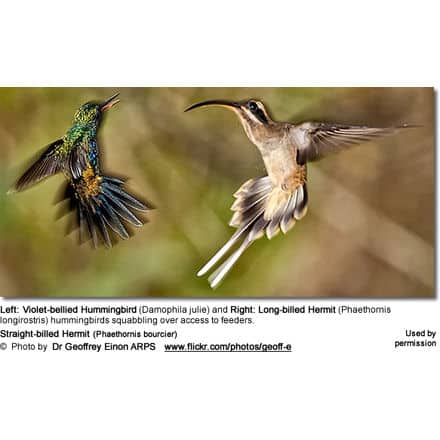
Diet / Feeding
The Long-billed Hermits primarily feed on nectar taken from a variety of brightly colored, scented small flowers of trees, herbs, shrubs, and epiphytes. They favor flowers with the highest sugar content (often red-colored and tubular-shaped).
Hermits are “trap-line feeders.” This means that they visit plants along a long route (in this case up to 0.6 miles or 1 km). This feeding technique differentiates them from most other hummingbird species which generally maintain feeding territories in areas that contain their favorite plants (those that contain flowers with high-energy nectar), and they will aggressively protect those areas.
Hermits have long, extendible, straw-like tongues which they retrieve the nectar while hovering with their tails cocked upward as they are licking at the nectar up to 13 times per second. They may be seen hanging on the flower while feeding.
Many native and cultivated plants on whose flowers these birds feed heavily rely on them for pollination. The mostly tubular-shaped flowers actually exclude most bees and butterflies from feeding on them and, subsequently, from pollinating the plants.
They may also visit local hummingbird feeders for some sugar water, or drink out of bird baths or water fountains where they will either hover and sip water as it runs over the edge; or they will perch on the edge and drink – like all the other birds; however, they only remain still for a short moment.
They also take some small spiders and insects – important sources of protein particularly needed during the breeding season to ensure the proper development of their young. Insects are often caught in flight (hawking); snatched off leaves or branches, or taken from spider webs. A nesting female can capture up to 2,000 insects a day.
Males establish feeding territories, where they aggressively chase away other males as well as large insects – such as bumblebees and hawk moths – that want to feed in their territory. They use aerial flights and intimidating displays to defend their territories.

Calls / Vocalizations
The male’s courtship song consists of high-pitched squeaky of chink churr and shree sounds. Its flight call is described as a high sweep.

